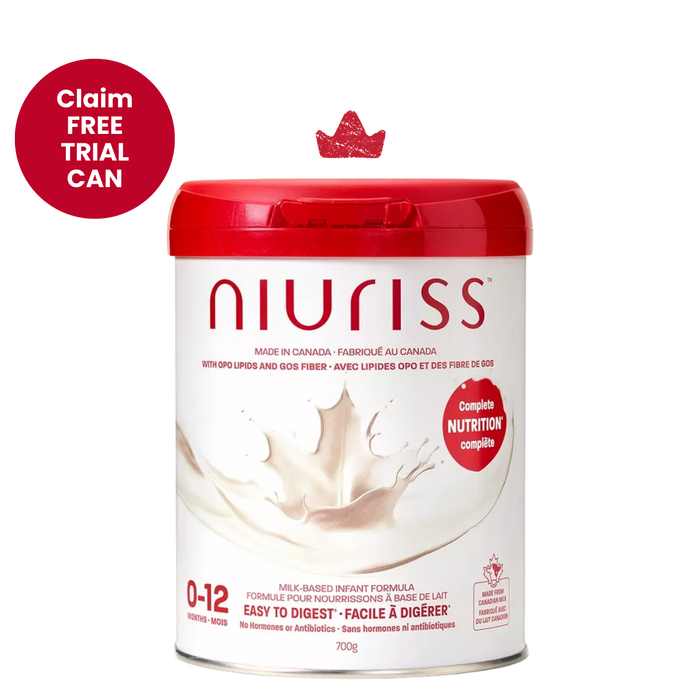

-

Formula feeding or Breastfeeding?
The most important thing to remember, whether you breastfeed or bottlefeed, is that your baby's feeding needs are unique. Understanding those needs is crucial. Whether you're combination feeding with breast milk or leaning into formula all the way, consult the guidelines below for a solid starting point.
-

What is combination feeding?
Many parents combination feed — using both breast milk and formula as needed. Also known as “mix feeding,” it doesn't just mean choosing breast milk for one meal and formula for another. Some parents follow breastfeeding with formula 'til their little one's full. And because milk supply can fluctuate, formula helps ensure there's always enough come feeding time.
Feeding Cues
Babies show hunger in different ways. Spotting your little one's cues will become second nature — and opportunities for bonding! Which of these signs do you see in your baby?
- Rooting (This means turning their head towards anything that touches their cheek! )
- Sucking on fists or hands
- Increased alertness
- Fussiness or crying (A late hunger cue. They might be quite hungry!)
- Lip smacking or tongue movement
- Nuzzling
- Putting things in their mouth
- Squirming or fidgeting
- Turning toward the breast or bottle
Fullness Cues
- Slowing down or pausing
- Spitting out bottle or closing mouth
- Turning away or losing interest
- Relaxed body language
- Falling asleep!
Powder Formula — Safe and Convenient
Don't worry — powder formula is just as safe as ready-to-feed formula. In fact, baby formula is one of the most highly regulated products in Canada, and you can start feeding it to your baby from Day 1.
Niuriss brand is proud to meet and exceed Canada's stringent food safety regulations. Our products are clinically tested, applying the latest in baby nutrition science to bring them closer to breast milk. And there are no hormones or antibiotics in our milk source — which you can trace with our Every Can Cares program.
Because your baby's safety and health are paramount, always!
Remember: newborn infants have tiny stomachs! At first, they'll need smaller amounts of human milk or formula, which will vary from baby to baby. While we provide a feeding reference chart below for a general understanding of approximate needs, no information source will precisely determine how much or often your baby needs to be fed — or exactly how you should handle them during feedings. These insights will come naturally as you and your baby bond, learning each other's preferences and rhythms!
A typical average intake for formula-fed infants is 150–200 mL/kg/day for the first three months of life. So, for example, if your baby was 2,500 g (2.5 kg or about 5 lbs, 8 oz), they would need approximately 150 mL x 2.5 kg = 375 mL/day, or 12.5 oz of formula/day. The upper range of this typical intake would be 200 x 2.5 kg = 500 mL/day (16.6 oz).
In general, breastfed babies usually take smaller, more frequent feedings in comparison to formula-fed infants. Formula-fed babies typically feed on a more regular schedule, approximately every three or four hours after one month of life. Formula feeding needs can be based on your baby’s weight for age and method of feeding. Some babies are fed a combination of human milk, formula and eventually solids.
Also keep in mind that growth and appetite play a role in how much your baby will eat from day to day. Solid foods should be started when developmental milestones have been achieved, which is typically between 4–6 months of age.
Nutritional Requirements for Infants Chart (1 U.S. oz ≈ 30 mL)
| Approximate number of feeding in 24 hours | Approximate time between feedings (hours) | Average amount of infant formula per feeding (oz/ml) | |
|---|---|---|---|
| First 24 hours | 8-12 |
2–3 | 0.5-2 oz/15-60ml |
| Day 2-7 | 8-12 |
2-3 | 2-3 oz/60-90ml |
| Week 2 | 8-10 |
2-3 | 2-4 oz/60-120ml |
| Week 3-4 | 6-8 |
3-4 | 3-4 oz/90-120ml |
| Month 2-3 | 6-8 |
3-4 | 5-6 oz/150-180ml |
| Month 4-5 | 5-7 |
3-4 | 5-7 oz/150-210ml |
| Month 6-8* | 4-6 |
3-4 | 6-8 oz/180-240ml |
| Month 9-12** | 3-5 |
3-4 | 6-8 oz/180-240ml |
Note: These feeding estimations are based on average requirements in healthy, term infants.
*At around 6 months, your baby will start to eat solid foods. Once your baby begins to eat more solid foods, they will begin to drink less formula.
**Depending on the amount of solid food your baby eats.
References
Food and Agriculture Organization of the United Nations. Human Energy Requirements. Chapter 3: Energy requirements of infants from birth to 12 months. Available at: www.fao.org/docrep/007/y5686e/y5686e05.htm (Accessed on March 20, 2018).
Manual of Pediatric Nutrition, 5th ed, Sonneville K, Duggan C (Eds), People's Medical Publishing House, 2014.
Dietitians of Canada. Infant Nutrition - Infant Formula: Summary of Recommendations and Evidence. Practice-based Evidence in Nutrition [PEN] (access by subscription). [Online] December 2022. http://www.pennutrition.com/home.aspx.
Other resources
Feeding Guide for the First Year | Johns Hopkins Medicine
How Much and How Often to Feed Infant Formula | Nutrition | CDC
Cow’s Milk and Milk Alternatives | Nutrition | CDC
Join the Nest: Niuriss Baby Formula Community
Raising a baby is a family affair! That's why we're proud to assist new parents and caregivers with their baby formula budget through the Nest. We offer a locked-in special launch price and more to safeguard against price increases for the first year. So you can focus on raising your newborn! After all, if they're happy, so are we — or your money back.
Create your account now to claim your first can of formula free with your first order — and enter to WIN $1,000 towards a registered education savings plan!





